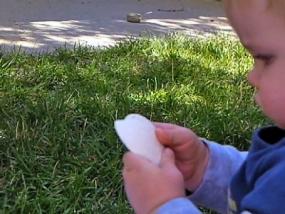The Paradoxical Shell

Truman, 11 months, rotates, probes, and rubs a white shell. Let’s try and figure out what he might be thinking. By reading his actions as high level thinking we reveal the incredible intelligence manifest during the first year of life, intelligence that is sadly often reduced to phrases like “hand-eye coordination” or “using the five senses.” This shell has two contrasting sides, one convex, one concave; one smooth, the other ribbed. Watch this video and decide if you agree that Truman is actually comparing these two sides. In other words, is he thinking how one side is not like the other?
00:11 Truman turns the shell over, convex side facing him. He pushes on the surface with his right thumb. This occurs immediately after he looks into the concave side of the shell and probes its depth with his right index finger. These two actions look like a pair, one done because of the other, one done to see how it differs from the other. These actions confirm that this paradoxical object is both convex and concave.
00:17 During these six seconds he flips the shell several times, looking at it, perhaps confirming that the differences he feels with his fingers are corroborated by what he sees.
00:25 The camera zooms in to capture the small movements of his fingers. He presses hard on the shell with both thumbs, pressing on the relief created by a ribbing on the convex surface of the shell.
00:43 He changes his firm press download into a sort of scraping over the ribbed surface of the shell.
He frequently changes which side is up by pronating his wrist 00:29 and 00:48. During these inversions, his finger tips are more fully in contact with the smooth inside of the shell. While we do not know if this contrast has entered his thinking, we do know that his hands have created this contrast for him to use. Much of early learning results coincidental to unintentional events. These events, once created, move into the consciousness of the child who subsequently makes the effect happen again with forethought.
At 00:53 we witness another contrast. His right hand releases his grip on the shell while his left hand holds it securely. At this moment, notice how he flexes his fingers, as if to say, “I have nothing in my right hand.” He has discovered the contrast between the substantial and the non-substantial.
Watch the rest of the clip and think about what you see this child do that reveals what he might be thinking. Place this thinking both in terms of what he discovers that the shell is and what he determines the shell (or a side) is not. The emergence of the concept “not,” as in “not smooth” serves as a foundation for even more abstract thinking. This way of marking development represents so much more than learning that something is smooth. Indeed, smooth itself has little meaning if it remains alone rather than compared to something that is not smooth. Paradoxically, a comparison, literally, is not “in” the shell but created by the working intelligence of a child. How can the senses feel something that is not literally there? They don’t. The child’s intelligence constructs a relation between the sensations.
